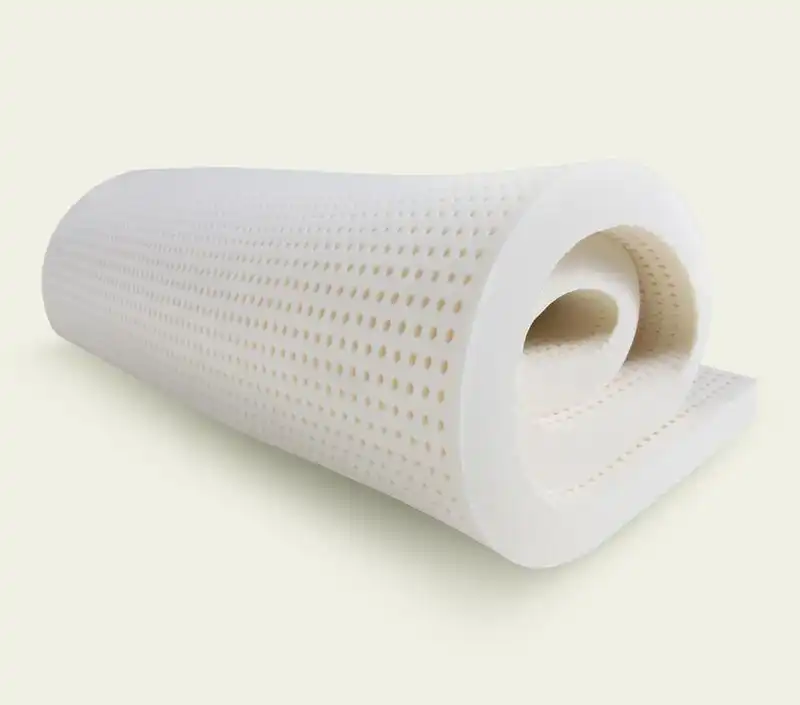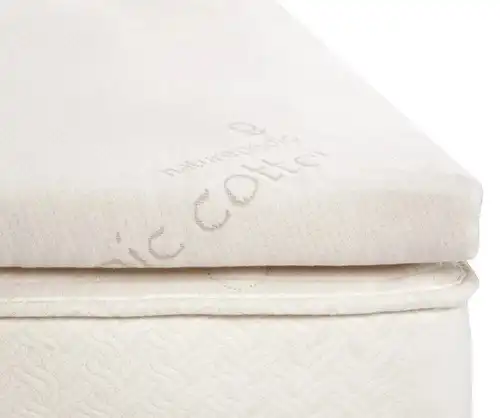- You are here:
- Home »
- Organic Mattresses »
- Are Latex Mattress Toppers Hot?
Are Latex Mattress Toppers Hot? An In-Depth Analysis
As an Amazon Associate I earn from qualifying purchases.
The type of mattress topper we use can greatly affect our sleep quality. Among the myriad of choices available in the market, latex mattress toppers have gained a significant following due to their numerous benefits, including durability, pressure relief, and natural materials.
In this article, we will help you find out if latex toppers sleep hot and how to choose the right topper for cool sleep.
Latex Mattress Toppers: What You Need to Know
Before delving into whether latex mattress toppers sleep hot or not, let’s first understand what they are. Latex toppers come in two forms: synthetic and natural. Synthetic latex is made from petrochemicals, while natural latex is derived from the sap of rubber trees. Both types have their own set of advantages and disadvantages.
Natural latex mattress toppers are known for their breathability, allowing air to circulate freely through its open cell structure. This means that heat can dissipate quickly, keeping you cool throughout the night. On the other hand, synthetic latex tends to trap heat and can cause discomfort for some sleepers.
|
$185
|
$173
|
$499
|
Understanding Heat Retention in Mattress Toppers
Heat retention is a common concern among mattress users, and it can greatly affect the quality of sleep. When our body temperature rises during sleep, our brain signals our sweat glands to produce sweat to cool us down. This is where the role of a mattress topper comes in – to regulate our body temperature and prevent excessive sweating.
Latex mattress toppers have a unique ability to balance out temperature changes. Its open-cell structure allows for better air circulation, preventing heat from getting trapped. This is especially beneficial for people who tend to sleep hot or those living in warmer climates.
Factors Contributing to Heat Retention in Latex Mattress Toppers
While the intrinsic properties of latex play a substantial role in the temperature regulation of a mattress topper, other influential factors must also be considered. These include:
Type of Latex:
Synthetic latex toppers tend to retain more heat than natural or blended latex due to their composition. This is because styrene-butadiene rubber (SBR), the primary component of synthetic latex, has a closed-cell structure that traps body heat instead of allowing it to dissipate.
The result is a warmer sleeping surface, which can be uncomfortable, especially for hot sleepers. Natural latex, on the other hand, has an open-cell structure that allows air to circulate freely. This means it doesn’t retain heat as much, leading to a cooler and more comfortable sleep.
Thickness:
The thicker the topper, the more material it has to retain heat. This applies to all types of toppers, including latex.
However, latex is more responsive and resilient than other materials, meaning it bounces back quickly when weight is applied. As a result, thicker latex mattress toppers may not necessarily feel hotter since they can still allow for air circulation.
Density:
The density of a latex mattress topper can also affect its ability to regulate temperature. Higher-density latex has smaller air pockets, which may trap heat more easily compared to lower-density latex with larger air pockets.
To know the density of a topper, check its pounds per cubic foot (PCF) measurement. A lower PCF (less than 4.3) usually means a more breathable topper.
Design Features or Technologies:
Some latex mattress toppers incorporate additional design features or technologies to further enhance airflow and reduce heat retention. These may include pinhole designs or aerated layers.
Most natural latex toppers use natural breathable covers, usually made of cotton or wool. These features can significantly improve the breathability of a topper and promote a cooler sleep.
Bedding Used:
The use of synthetic mattress protectors and sheets can retain heat and hinder air circulation, thus affecting the overall temperature of the latex mattress topper.
To maximize breathability and maintain a cool sleep surface, use organic mattress protectors and sheets made of natural materials, such as organic cotton, Tencel or hemp.
Mattress
The type and condition of the mattress itself can also contribute to heat retention. If your mattress is already too warm, adding a latex topper may not solve the issue entirely. Moreover, if your mattress has poor air circulation or retains heat, it can transfer that warmth to the latex topper as well.
Memory foam mattresses tend to trap more heat than organic mattresses made of natural materials, so keep this in mind when choosing a mattress topper.
Read More: Do Latex Mattresses Sleep Hot?
Top-Rated Latex Mattress Toppers for Heat Management
Based on online reviews and product details, here are three top-rated latex mattress toppers known for their excellent heat management:
My Green Mattress Topper
Materials: GOLS certified organic latex and GOTS certified organic cotton
Available sizes: Twin, Twin XL, Full, Full XL, Queen, King, Cal King
Made of 100% organic GOLS-certified Dunlop latex and featuring a pinhole design, this topper allows for excellent air circulation, making it an ideal option for hot sleepers.
The zippered organic cotton cover also adds to its breathability and wicks away moisture. My Green Mattress Topper is designed to make your mattress feel softer and cooler, without compromising on support.
Latex for Less Mattress Topper
Materials: OEKO-TEX certified latex and GOTS certified organic cotton
Available sizes: Twin, Twin XL, Full, Queen, King, Cal King
Made from 100% natural latex, this affordable latex mattress topper is praised for its breathability and comfort. Latex for Less Mattress Topper comes in three different comfort levels and an organic cotton cover is available separately.
Naturepedic Adagio Organic Latex Topper
Materials: GOTS-certified latex and organic cotton
Available sizes: Twin, Twin XL, Full, Queen, King, Cal King
This luxury topper features organic latex and a plush organic cotton cover. Adagio Latex Topper is Greenguard GOLD certified to meet rigorous standards for chemical emissions, making it a safe and healthy choice.
Read More: Best Alternatives to Memory Foam Mattresses
Tips on Choosing the Right Latex Mattress Topper for Cool Sleep
If you’re considering a latex mattress topper, here are some tips to help you choose the right one:
- Look for natural latex: As mentioned earlier, natural latex has better breathability compared to synthetic ones. Not only is it more eco-friendly, but it also provides a cooler sleeping surface.
- Choose a density that suits your needs: Latex mattress toppers come in various densities, which can affect its ability to regulate temperature. A higher density may provide better support but can also trap heat more.
- Consider the thickness: The thickness of a latex mattress topper can also affect its cooling capabilities. Thinner toppers tend to sleep cooler compared to thicker ones since there is less material for heat to get trapped in.
- Look for certifications: Make sure to choose a latex mattress topper that is certified by reputable organizations, such as the Global Organic Latex Standard (GOLS) and Global Organic Textile Standard (GOTS). These certifications ensure that the latex used is from sustainable sources and free from harmful chemicals.

Conclusion
So, are latex mattress toppers hot? While they can retain some heat due to certain factors, they generally stay cooler than many other types of mattress toppers. This is mainly due to the natural breathability of latex and specific design elements aimed at enhancing airflow.
Personal factors, such as your body heat, climate, and the type of bedding used, can also affect how hot a mattress topper feels to you. Therefore, when choosing a latex mattress topper, consider factors like thickness, natural vs synthetic latex, any additional cooling technologies, and the type of sheets or protectors you intend to use.
About the Author Kamila Flieger
My name is Kamila, and I'm passionate about researching non-toxic, organic products for the home. I believe it's so important to create a safe and healthy environment for our families, and I enjoy helping others do the same.




